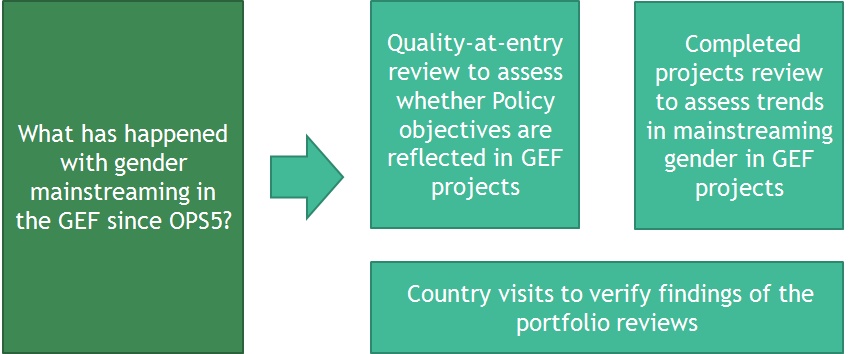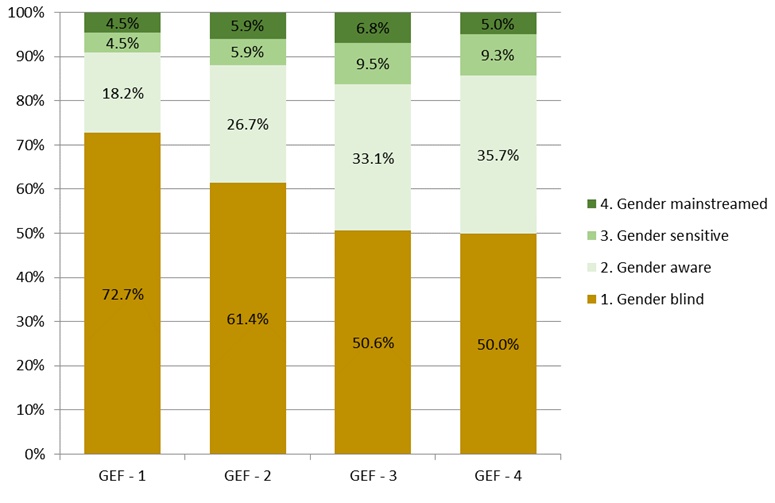Evaluation of gender mainstreaming in the GEF - Part 1
Over the past year the Independent Evaluation Office (IEO) has worked on an evaluation of gender mainstreaming in the Global Environment Facility (GEF). The objective of the evaluation was to follow up on an earlier study, the OPS5 sub-study on gender mainstreaming, and to assess the progress towards achieving gender mainstreaming and women's empowerment since October 2013 – the data deadline of the previous Overall Performance Study (OPS) of the GEF. Findings of this evaluation aim to inform the final report of the Sixth Overall Performance Study of the GEF (OPS6), and the revision of the GEF Policy on Gender Mainstreaming, which the GEF Secretariat is updating for submission to the 53rd Council Meeting in November 2017.

The May 2011 GEF Policy on Gender Mainstreaming expresses GEF's commitment to enhancing the degree to which the GEF and its Partner Agencies promote the goal of gender equality through GEF operations. The objective of the GEF Policy on Gender Mainstreaming is that "the GEF Secretariat and GEF Agencies shall strive and attain the goal of gender equality, the equal treatment of women and men, including the equal access to resource and services through its operations." The policy requires GEF Agencies to have policies or strategies that satisfy seven minimum requirements to ensure gender mainstreaming.
The Gender Equality Action Plan of October 2014 is intended to serve during the GEF-6 period, and consists (among other things) of a step-wise approach in achieving the goals and objectives of the GEF Policy, ensuring that project results and progress related to gender can be better designed, implemented, and reported.
In this Part 1 blog post I will discuss the findings of a quality-at-entry review of projects and a review of completed projects, covering 550 GEF projects. The quality-at-entry review looks at whether GEF gender policy objectives are visible in GEF projects' design and the review of completed projects looks at longer-term trends in gender mainstreaming in GEF projects

The project baseline, part of the earlier study, was re-assessed because of the use of a new gender rating; this re-assessment covered 663 GEF projects. More than 8,500 documents of 1,213 projects were reviewed and field visits took place to verify findings of the two project portfolio reviews (at entry, and at completion).
As said, a new gender rating was used as part of this evaluation. The gender rating has been piloted in the program evaluations of the LDCF and SCCF, and rates projects from ‘gender blind', ‘gender aware', ‘gender sensitive' and ‘gender mainstreamed' to ‘gender transformative', with GEF's Policy focusing on gender mainstreaming as globally accepted strategy for promoting gender equality. Projects going beyond the policy goals, and facilitating a critical examination of gender norms, roles, and relationships beyond the project's scope are regarded as ‘gender transformative'. The gender rating is further explained in the evaluation report.

Quality-at-Entry Review
- Gender considerations in project documentation improved. Comparing OPS6 quality-at-entry data with the OPS5 baseline data the biggest gain can be seen for medium- and full-size projects (MSP/FSP) where gender consideration in project documentation rose from 56.5 percent to almost 98 percent. However, improvements in the inclusion of gender considerations do not tell whether such considerations are meaningful towards the goal of gender equality.
- While over 70 percent of projects made use of gender disaggregated indicators, only 17.8 percent included gender specific indicators in their project's results framework. Gender specific indicators either measure the results of gender specific activities and objectives, or provide separate measures for men and women; such as separate vulnerability indicators that take into account gender specific roles, needs, and access to resources.
- Fifty-two percent of projects either planned or conducted a gender analysis at CEO endorsement – the moment of a project being officially accepted by the CEO of the GEF. This is surprising, given that to align with the minimum requirements of the GEF Policy on Gender Mainstreaming the GEF Agency is required "to undertake social assessment, including gender analysis, or to use similar methods to assess the potential roles, benefits, impacts and risks for women and men of different ages, ethnicities, and social structure and status. These studies may be used, along with other types of studies to better inform project formulation, implementation and monitoring and evaluation." Given that the aim of a gender analysis is to facilitate the strategic use of distinct knowledge and skills possessed by women and men into the project's design, the evaluation team asserts that a gender analysis needs to take place as part of the project design process, in advance of CEO endorsement/approval.
- None of the projects lacking mention of a gender analysis or social assessment were rated gender mainstreamed. And less than five percent of these 124 projects were rated gender sensitive. Most these projects (114 out of 124) were rated gender aware. The meaningful inclusion of gender in project review and design demands a gender analysis or social assessment with gender elements.

The biggest change over time is that in the OPS6 cohort of projects only four projects (1.3 percent) are rated gender blind, compared to 64 percent and 29.2 percent of projects in the OPS5 Pre-May 2011 and Post-May 2011 samples respectively. The biggest increase under OPS6 is in the category ‘gender aware'. While it is positive that fewer projects are gender blind, the growth in the rating categories ‘gender sensitive' and ‘gender mainstreamed' is limited.
Completed Projects Review
A portfolio review of project documents, mid-term reviews and terminal evaluations of a sample of completed GEF projects submitted since OPS5 has been concluded to provide a picture of trends in mainstreaming gender in GEF projects with regards to project results, and as an update on the findings from the similar exercise conducted for OPS5.
Most of the completed project reviewed are from GEF-3 and GEF-4 replenishment phases. Only 26.5 percent of completed projects reviewed included gender-disaggregated indicators. Three projects (1.2 percent) made use of gender specific indicators in their project's results framework. A gender analysis took place for 15.6 percent of the completed projects, and roughly 45 percent of projects reviewed are gender blind. Forty-one percent of projects were rated gender aware, 11.2 percent were rated gender sensitive and six completed projects were rated gender mainstreamed (2.4 percent).
We need to keep in mind that projects for which terminal evaluations were received over the past 3-4 years were most of the time designed well before the 2011 GEF Gender Policy coming into effect. Whereas the project-at-entry review looked at projects' design, the review of completed projects focused on gender results achieved, either by design or by chance.
Combining OPS6 and OPS5 data for completed projects results in a dataset of 537 completed projects, in order to provide a picture of the trends in mainstreaming gender in GEF projects.
Through the GEF-phases, one sees a clear, albeit slow, improvement when it comes to gender in GEF funded projects. The evaluation team combined OPS5 and OPS6 gender rating data for completed projects to review the performance across GEF phases for a combined dataset of 537 projects. The pilot phase and GEF-5 were not taken into account, given the low number of completed projects for these phases not being representative. Through the GEF-phases, one sees a clear, albeit slow, improvement when it comes to gender in GEF funded projects. Comparing the GEF-3 and GEF-4 phase, which perform in a similar fashion, one has to take into account that GEF-4 terminal evaluations are still being received, so the overall performance of the phase is expected to change over time, as new data is taken into account.

Recap
Keep in mind that it takes time to see the actual results of a Gender Policy in project results; project design takes 18 to 24 months, projects have an average project lifetime of 5 years, and the implementing agencies have 18 months to complete and send in their terminal evaluations once a project closes. The first terminal evaluation results of projects being designed after approval of the GEF Gender Policy are expected early 2020.
This also means that the GEF Policy on Gender Mainstreaming cannot be evaluated against project results. In the next blog post I'll discuss the analysis of the GEF gender policy against international good practice.
Some Resources:
- GEF, Policy on Gender Mainstreaming, May 2012. Policy Document GEF/SD/PL/02.
- GEF, Gender Equality Action Plan (GEAP), October 2014. Council Document GEF/C.47/09/Rev.01.
- IEO, Evaluation of Gender Mainstreaming in the GEF, May 2017. Council Document GEF/ME/C.52/Inf.09.
- IEO, Program Evaluation of the LDCF, June 2016. Council Document GEF/LDCF.SCCF.20/ME/02.
- IEO, Program Evaluation of the SCCF, May 2017. Council Document GEF/LDCF.SCCF.22/ME/02.



